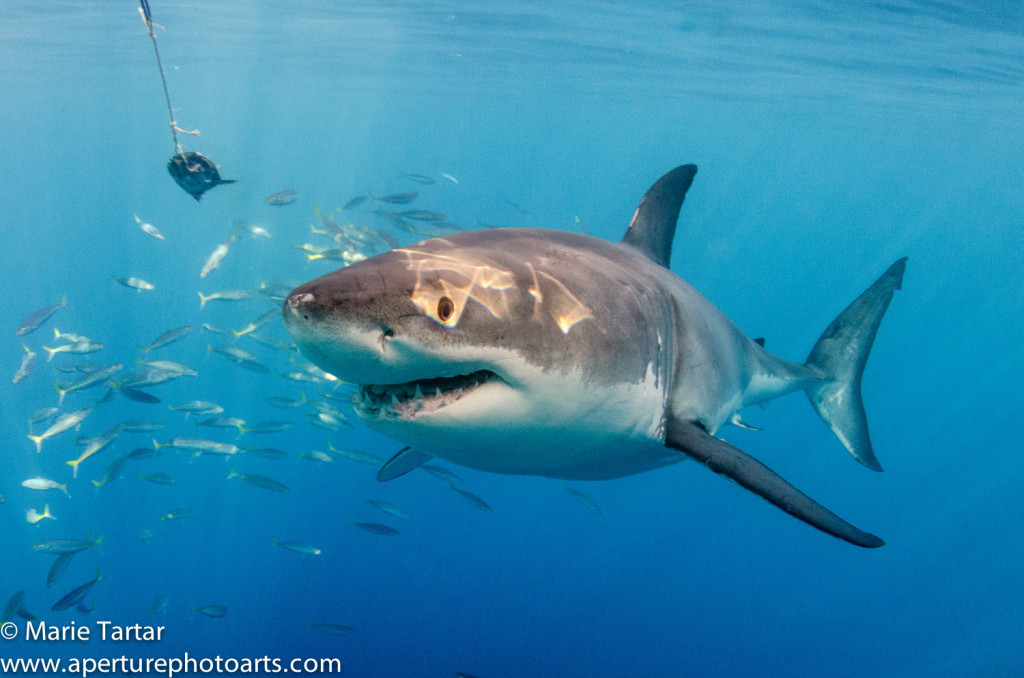
Rolling, rolling, our boat, the Horizon, tosses us from side to side as though possessed as it plows its way southwest from Ensenada, Mexico en route to Guadalupe Island. Seasickness bubbled just below my surface calm, barely held at bay by half a Scopolamine patch behind my ear. Even the crew complained, “This crossing is awful!”
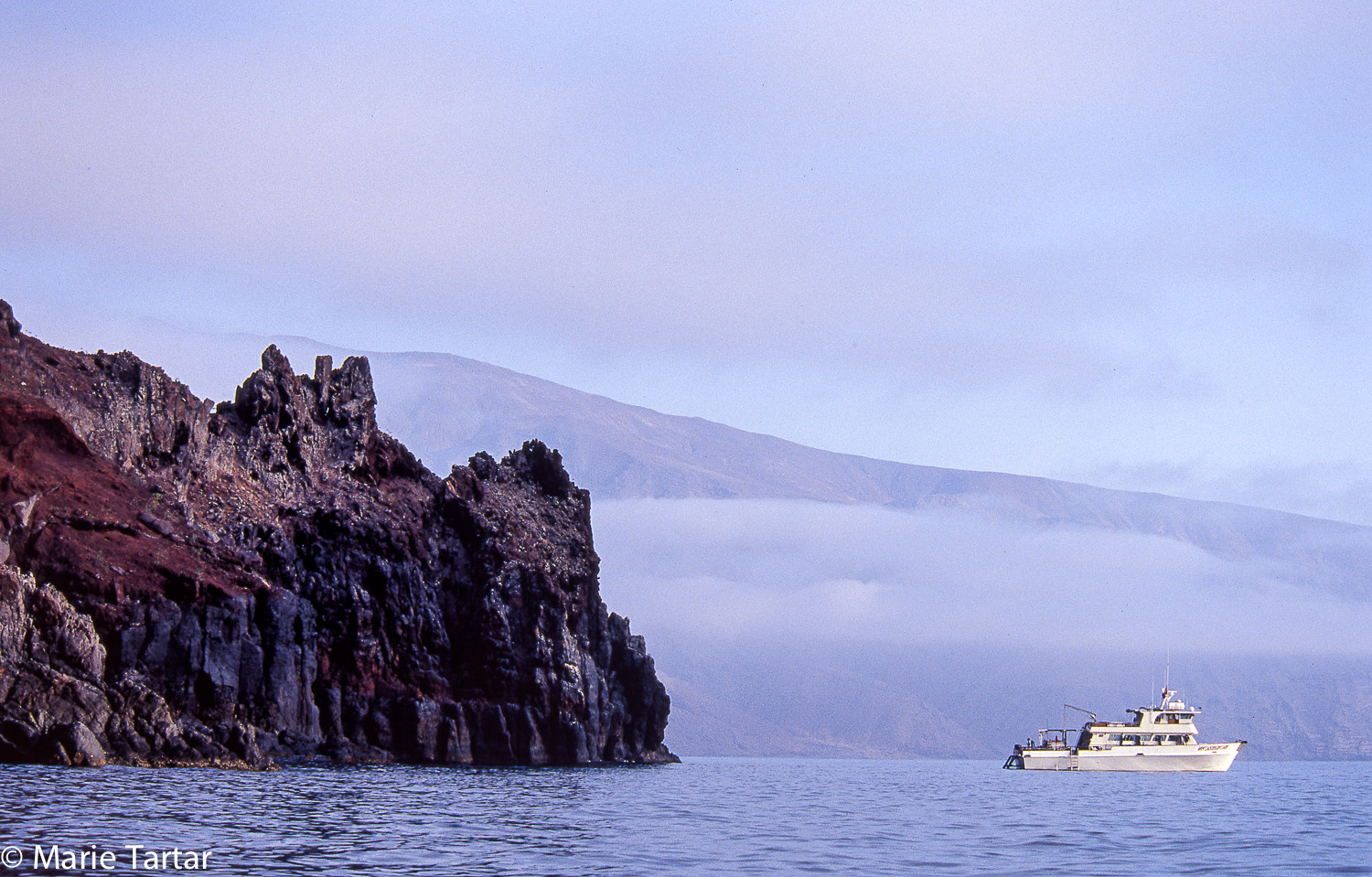
The Horizon as seen from a zodiac. Yes, back in the diving days, trips included zodiac excursions, good opportunities for photography of the wildlife hauled out on the rocks.
I was en route to spend 3 days at the Island, planning to spend hours in the water just below the surface, in a metal cage. We have a friend, Greg, who has done a comparable trip every year for the past 5 years and many other friends who have traveled as far as South Africa to do just this.
The attraction, for which people will pay $3000 or so, very possibly including 2 seasick miserable days crossing back and forth: none other than the apex predator of the sea, the great white shark (Carcharodon carcharias).
For me, this trip beckoned like destiny. I can site 5 separate influences leading me to want to see great white sharks eye to eye, none of them being the movie “Jaws.”
First:
Years ago, I was circled by a great white shark in the Farallones Islands, in Northern Californian waters, 27 miles from San Francisco. This was witnessed by many, but not by me (thankfully). I was diving (not in a cage) in one of their residences, so perhaps this shouldn’t have been surprising. The Farallones Islands are a National Marine Sanctuary, rarely visited, much less dived, in part due to their most famous and feared resident, the great white shark.
Then and now, opportunities to enter these waters are rare. The excursion we joined was one of the last charters on a boat that would soon be suspending operations. Bay area friends Ruth and Jason (who we met on a Channel Islands trip) raved about the pristine diving and abundant color and life, persuading us to join them on a weekend trip. It was an eventful weekend. Read about it here: https://aperturephotoarts.com/farallons-fiasco/
Second:
Steve and I dove without cages at Guadalupe Island 11 years ago, in 2003, joining our friend Skip on a then annual summer diving expedition on the Horizon to this isolated volcanic island in Northern Mexican waters. Guadalupe has since become a well-known destination for great white shark encounters, one of 3 in the world (the others being South Africa and southern Australia). This was a nascent industry at the time, with the first scouting trip in 2000, and the first commercial trip in 2001.
Diving, we reveled in the cool, clear blue water and visibility, contrasting beautifully with golden hued kelp, as Guadalupe fur seals playfully pausing in front of us trailed streams of bubbles from their thick fur.

The Guadalupe fur seal was the marquee animal attraction of diving Guadalupe. This species was once thought to be extinct.
We did not dive in cages, but knew great white shark encounters were possible, especially likely just a few months later in the year. Derek, a wiry, very capable spearfishermen among our group, saw a great white shark twice while underwater, and we all saw further evidence of their ominous presence from the boat, the headless carcass of an elephant seal. I later learn that elephant seal carcasses float (as opposed to those of sea lions).
We were just wigged out enough by these sights that we declined the invitation to return the following year.
Third:
Although it is universally acknowledged that death from shark attacks is exceedingly rare, we actually knew someone who died from a great white shark injury. In 2008, our next-door neighbor for 7 years from Solana Beach, Dave Martin, a tall, handsome, blonde, retired veterinarian training for a triathlon, was swimming with other triathletes in training at our former home beach, Fletcher’s Cove, when he was bitten by a presumed great white shark and bled to death.
Fourth:
Our long-time friend, Martin Graf, became in recent years CEO of Sharkdiver.com, organizing “safe and sane” trips around the world for viewing sharks, including a series of trips from August-November every year to Guadalupe for white shark encounters. Following his posts over the years on Facebook, my curiosity progressively intensified, especially as our friend Greg returned year after year (this year, the 5th in a row) to Guadalupe during white shark season.
Fifth:
Guadalupe is in our backyard, with San Diego the springboard for divers (and non-divers) around the world to board boats bound for Guadalupe to see great white sharks in the wild, in the clearest water of the available options.
So, was this curiosity, facing a deep-seated fear, or something else? The great white shark isn’t an animal that has been successfully maintained in captivity (the record is 6 months at Monterey Bay Aquarium), so seeing one without getting in the water is not an option. It is, after all, considered the apex predator of the aquatic food chain, and remains shrouded in mystery, the source of legend and lore.
Dinner with Martin earlier in the summer made me aware of a still open berth on a trip over Labor Day, a weekend Steve was scheduled to work. He had never been as intent on seeing the sharks as me, and I already had most of the necessary days off…Done! Why not now?
Preparing for this trip was easier than for a dive trip. We wouldn’t be swimming around, so no need for fins. We wouldn’t be donning tanks, so the BCDs and regulators could stay at home. If desired, Shark Diver will supply (included in the price) wetsuits, masks, hoods, a nice arrangement for traveling divers. Our friend Phil Colla (www.oceanlight.com), a veteran of many trips over the years to Guadalupe and one of the finest underwater and landscape photographers I know, encouraged me to leave the strobes at home, citing limited space in the cages, streamlining my camera gear.
Our group was quite international, including 2 men from Turkey, a father and recent university graduate daughter from Milan, a son from Texas on a return trip with his father, a single woman from Alberta, a marine biologist specializing in corals and sharks working at an aquarium in Brisbane, Australia, and 2 young men from London joining a mass 30th birthday celebration with other friends in Las Vegas after this trip. One man from Fort Lauderdale, Florida, is on his 3rd trip in 3 years.
Our crew consisted of captains Spencer and Cary, deckhands Ryan, Patrick and Danny, chef Mark and sous-chef Shea in the galley, and Martin as dive master. They were a friendly and welcoming group.
Danny, the youngest deckhand, attributes his being on the boat to being obsessed with sharks since first viewing Jaws at age 4. After finishing his film degree, he found he yearned for something other than sitting at a desk in Manhattan. Through a series of coincidences, he connected with Martin, who noticed in his email address a reference to his college. It turns out Danny did know the son of Martin’s old cycling buddy…
Guadalupe Day 1 : We arrived early in the morning. My intention to be up early to see the cages set in the water was foiled by the more pressing temptation to sleep a few more hours. I did make it up in time for Martin’s demonstration of how to enter the cages. They are positioned side by side, along the stern of the boat, and hold 4 divers (sometimes 5, with Martin) at a time. Entrance is backwards down a ladder through a trapdoor in the cages’ ceiling, which is flush with the water’s surface. We were divided into 4 groups of 4, 2 groups in for an hour at a time, alternating with the other 2 groups. Thankfully, I was in the second group, with Kathleen, Mark and Robert P. Kathleen is from Alberta and is the only passenger who is not a certified diver. With this trip, she achieved the unheard-of, crossing off the last item on her bucket list! Martin has thoughtfully divided the group so that the few people like me with bulkier SLR cameras with dome ports are paired with divers with small cameras and GoPros. My group is nice enough to let me take the photographer-coveted outside corner position each time.
Cage diving is unlike normal SCUBA diving in every way. We were intentionally over-weighted to keep us somewhat stabilized. (I was sent down with 36 pounds in a DUI harness, which puts the weight on your hips. For me, this proved to be really uncomfortable. I shed weight on subsequent dives, down to 30 pounds and then to 24 pounds, and didn’t really notice a difference in stability. I also hiked the weight up higher, onto my waist, which was more comfortable). The cage has aluminum bars, and a horizontal window, which I could reach with the aid of a milk crate as a step. The cage bobs on the surface, making it hard to feel stable inside the cage. We had to hang on to the bars, trying not to have body parts sticking out at shark range. Greg had told me that sharks sometimes ram the cage, and to always be prepared to retreat into the cage, but we didn’t really experience any violent encounters.
We didn’t have long to wait for our first visitation by the Landlord. Their immensity is literally breathtaking, especially in contrast with the spindly-in-comparison cage bars. To attract them, fish heads are tossed on floats by crewmembers at the back of the boat.
Sometimes, they are left to bob, attracting a crowd of scad mackerels, with more occasional beefy yellow-tailed amberjack zooming in to break up the pack. At other times, they are dragged through the water in an attempt to lure the sharks in closer to us.  Most of the time, the sharks are not fed, with the bait reeled away just in time.
Most of the time, the sharks are not fed, with the bait reeled away just in time.
When they do come in close, it was hard not to involuntarily recoil, losing one’s tentative grip on the cage, leading to a struggle to rebalance. On at least one occasion, I actually screamed into my regulator, so startled was I on turning to the side to find a great white shark, larger-than-life, just-there!  The shark’s ability to suddenly appear exemplifies counter-shading, with the shark steely-grey-brown on top merging visually with the water surface and the underside white, which from below blends in with the brightness of the sky.
The shark’s ability to suddenly appear exemplifies counter-shading, with the shark steely-grey-brown on top merging visually with the water surface and the underside white, which from below blends in with the brightness of the sky.
Another time, I mentally if not actually screamed, turning to the side, finding the gap-mouthed fishhead bait dangling slack-jawed at my side, the stuff of nightmares.
Cage diving isn’t as leisurely and free as normal diving. Even breathing feels like hard work. We are Hookah diving, breathing off a surface source of air through hoses and regulators. I frequently had to adjust the position of the regulator in my mouth to retain it and miss my custom-molded mouthpiece. During my third dive, my hose became so coiled up and uncomfortable, I had to take my regulator out of my mouth and unwind its loops.
I’m wearing a thicker wetsuit than usual, which keeps me warm enough for an hour session in the “pool.” Getting into it is greatly aided by liberal applications of “suit juice,” mixtures of hair conditioner and water. The water temperature is relatively warm, 74 degrees F, although I remember wearing a drysuit for water temperatures on the order of 66 degrees on our prior trip.
For the first 2 sessions, I take my camera (Nikon D7000 with a Tokina 10-17 mm lens). For the afternoon, I take Steve’s newly serviced D7000, with a Nikon 12-24 lens with a 2+ diopter.
On the surface, the sleek bodies of the sharks can be clearly seen, heralded by Patrick’s singing out “White shark!” with each close pass. More than once, fish monger imagery comes to mind on this trip.
The shark population visualized at Guadalupe varies somewhat by the time of year. Earlier in the season (August and September), males predominate. They tend to be more inquisitive and active. This was certainly our experience on our trip over the Labor Day holiday. Later in the season, in October and November, fewer sharks are seen, but the larger females start appearing.
Surprisingly wide gaps still exist in our knowledge of white shark biology. Females are presumed to mate at Guadalupe, although this has never been observed. They have been noted to appear at the Island in alternate years, presumably mating one year, then spending their long gestation (estimates range from 14-18 months) offshore before giving live birth to litters on the order of 14 pups (as known from a cadaver specimen).
Tracking studies have shed some light on their whereabouts at other times. There is an area known as SOFA (shared offshore feeding area) or Shark Café, offshore of Hawaii, where great white sharks feed, females at certain times, males at others. But much remains unknown.
On Day 2, our group was the first to enter, now in the left cage, although the prior hour had been an optional open hour. Our first session did not disappoint! We are treated to many close passes by huge sharks, including Johnnie, who seemed quite ready for his close-up. Many of the sharks are known and named. Martin estimated we saw 11 different sharks, including several newcomers. He keeps a shark ID book and logs their sightings. Individual white sharks can be recognized by the unique patterns at the grey-white interface at the gill level. Many sharks (such as Chugey, pictured above and below) bear obvious marks of violent encounters, presumably inflicted by other sharks. Biting is thought to be a component of mating.
Many sharks (such as Chugey, pictured above and below) bear obvious marks of violent encounters, presumably inflicted by other sharks. Biting is thought to be a component of mating.
The water clarity varied from excellent to literal shit storm, with one shark pooping in several passes up water from us, coupled with tiny jellies (which stung my face repeatedly on the 3rd dive of the first day, leaving me with red welts on my cheeks, just in time for not one, but two black tie events the weekend after my return!) and fish gut slick.

White sharks surprise attack their prey at the surface from below. The shark and prey in its mouth may be launched out of the water in the process. The shark may drag the bleeding animal below while extracting a chunk of flesh, before releasing it temporarily.
Not every dive was full of activity and visual fireworks. Our second dive was comparatively quiet, while our third looked to be a bust until the final quarter hour.
On Day 3, our first dive was book-ended by quick passes by Johnnie on entry and just before being recalled, but was otherwise mostly waiting. The water was milky blue, the cage bouncier, and the boat and cage positions varied more, swinging at times almost perpendicular to the shore. By the time we exited, there was one sole viewer in the other cage, and just me and Kathleen in ours. Underwater, my mind drifted, making up stories about the scad mackerels chasing the fish heads to entertain myself. It was never clear why one suspended fishhead might be mobbed, and the other drift lonely.
I imagined a hawker singing out: “Fishheads, get your rotten fishheads!”
Between dives, there was the surface activity to watch, warming up in the shower and sun, snacks, downloading cards and even a little time to read. I found myself enthralled by a book I found on board, The Devil’s Teeth by Susan Casey, published in 2005, about great white sharks and shark researchers in the Farallones Islands.
Since my return, I’ve had sharks circling in my brain, swimming in lazy circles, almost indolent, more curious than frightening. They are indeed possessed of formidable bulk and speed, not to mention dagger-sharp teeth (with rows to spare), but mindless eating machines of popular lore? No, it would be more accurate to say a complex mix of deliberation and caution. A video clip gives of a sense of the almost langorous nature of the encounters which were typical of our trip: https://vimeo.com/105452146.
It was an unforgettable experience being the animal in the cage, inspected by the passing sharks, sometimes regarding each diver in turn, sometimes disappearing within seconds into the unfathomable reaches of the ocean to remain a mystery, a riddle we may never entirely solve.
-Marie


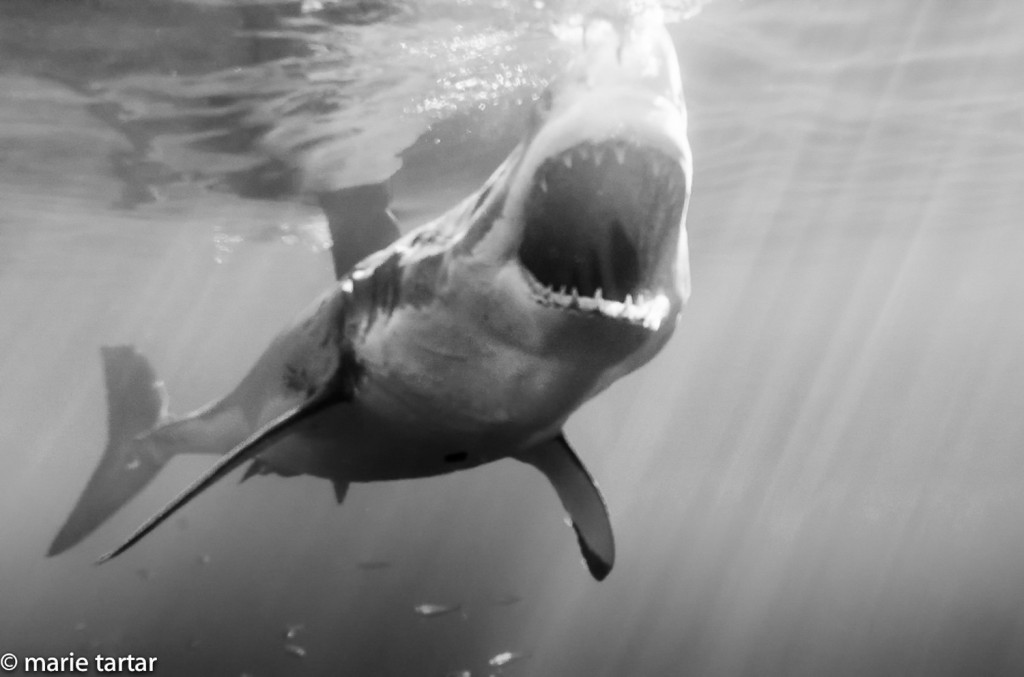

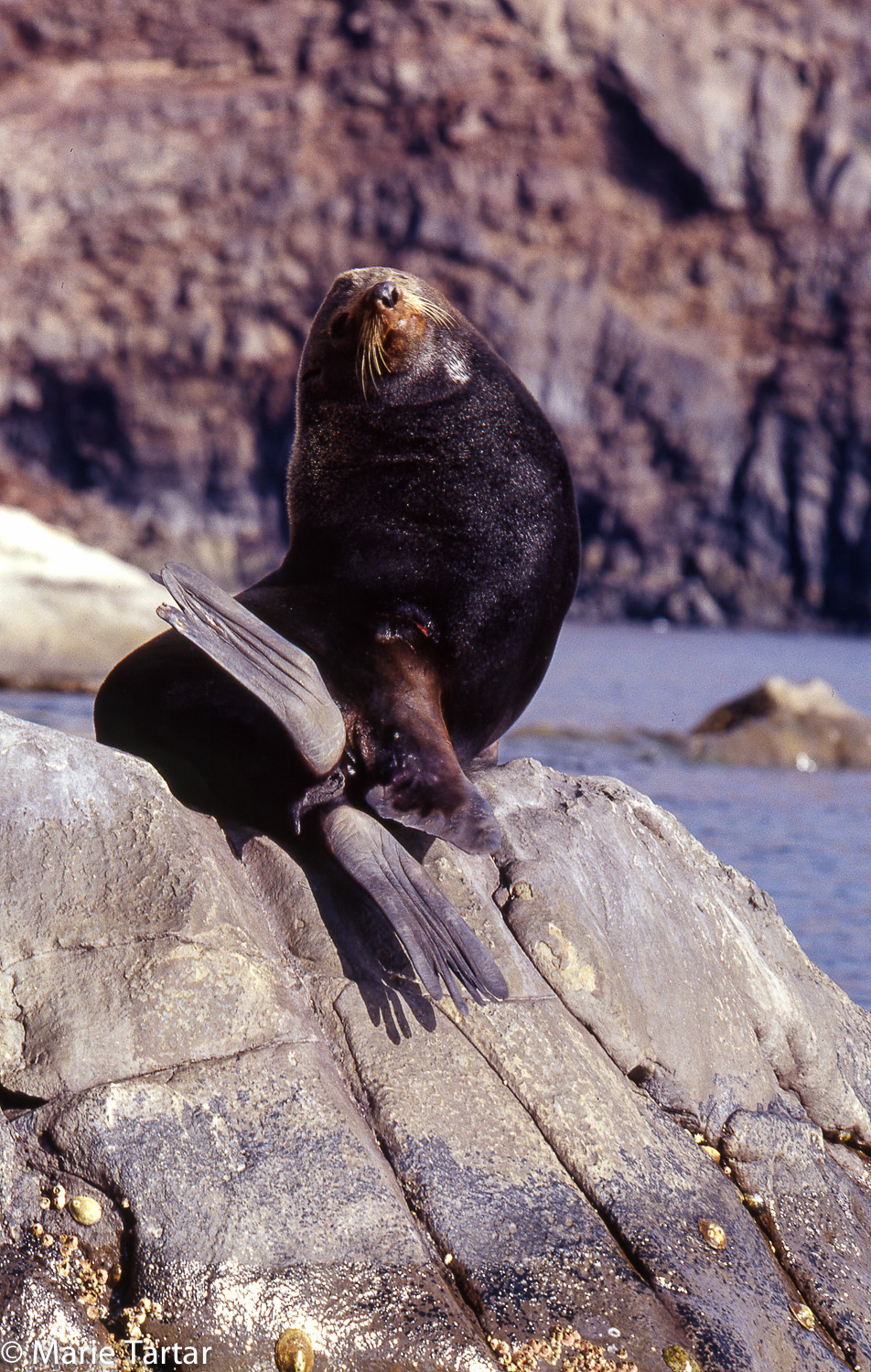

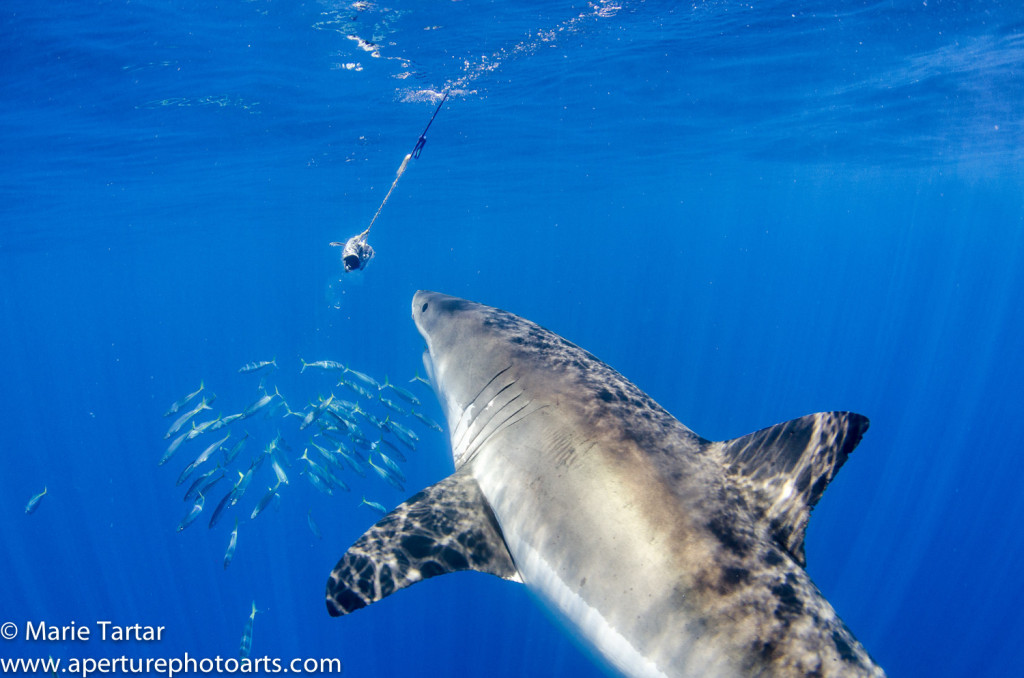


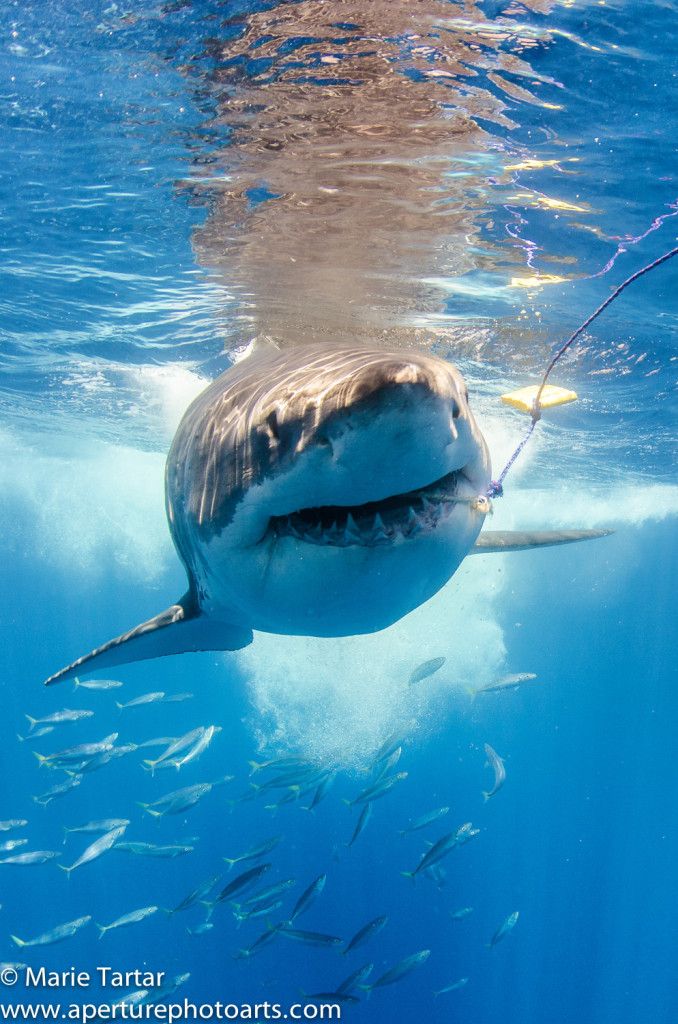
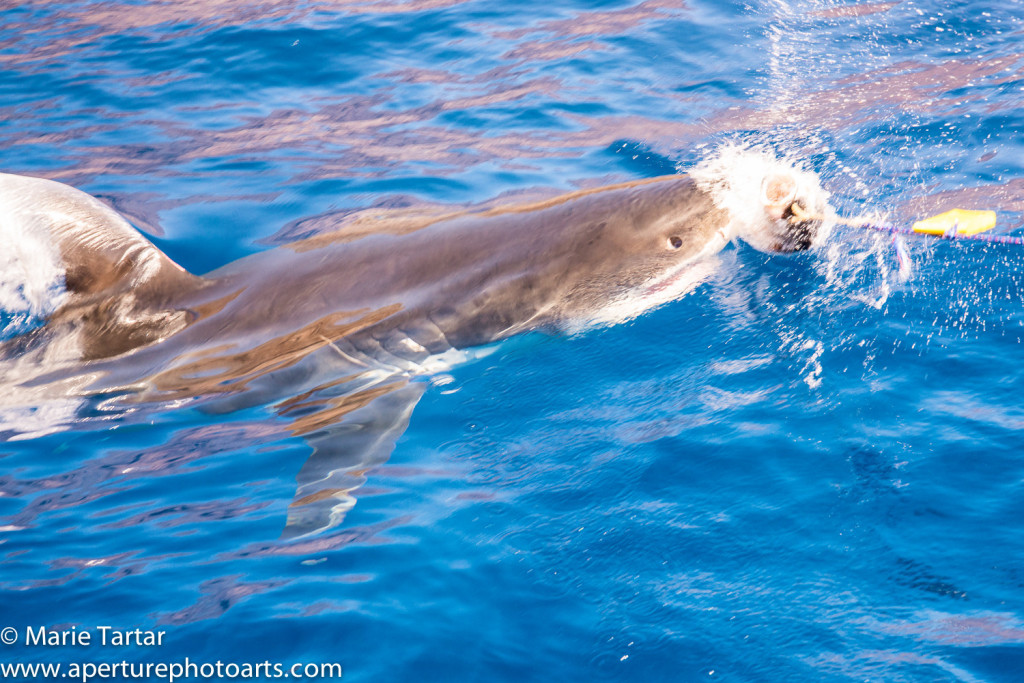
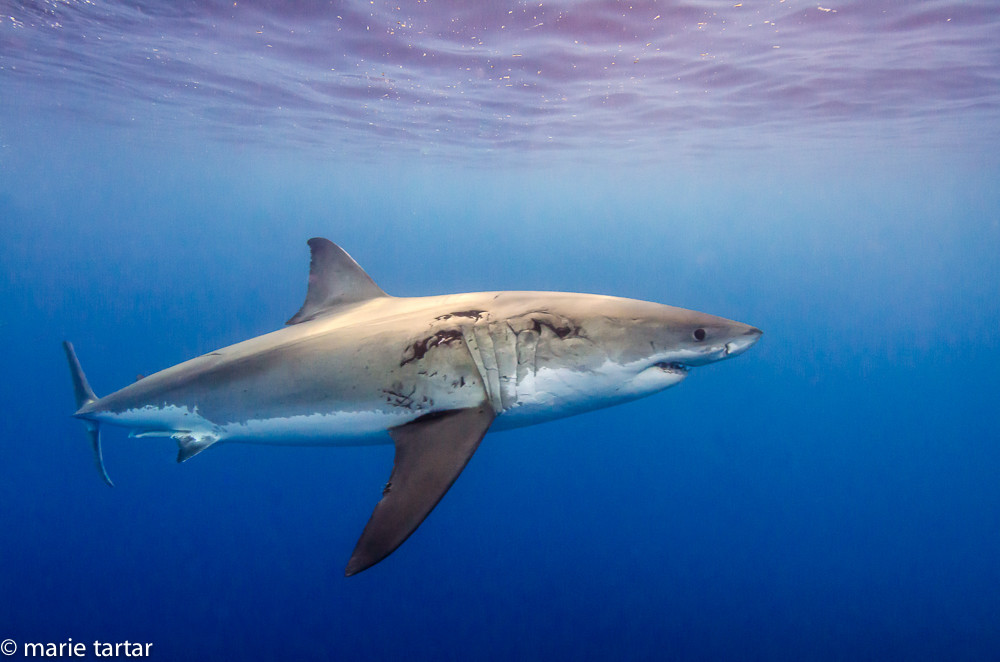

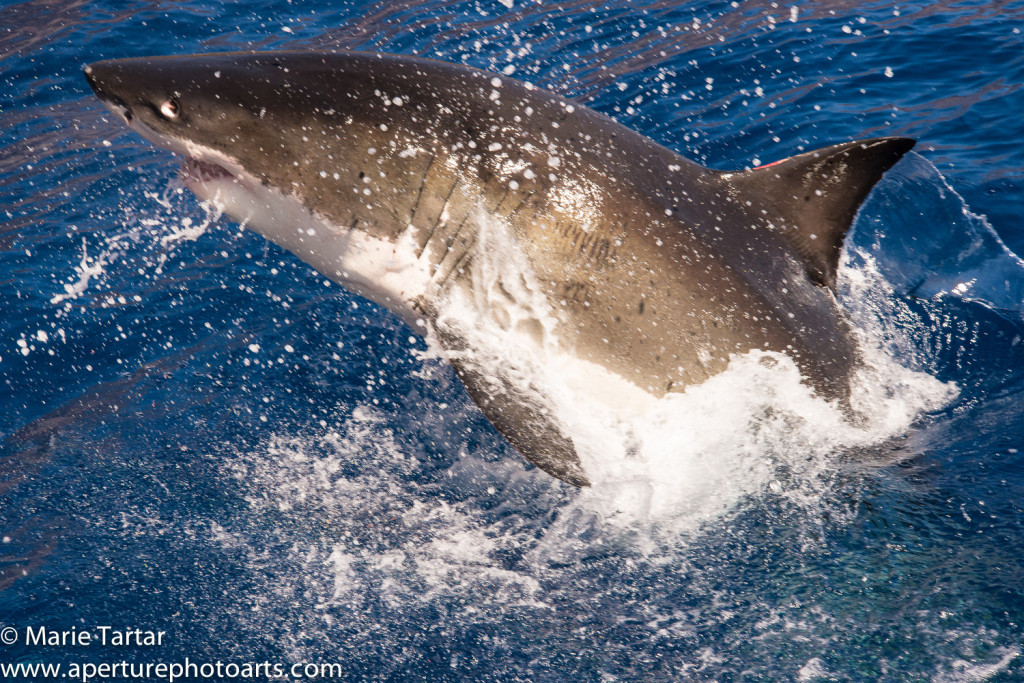
Stunning photos, accompanied by an enthralling narrative making it my perfect armchair shark encounter.
s
Great work Marie, and great reporting! I remember your first report handed in to me after your adventure at the Farallones. I too read Casey’s book a few years ago and thought it pretty good. She wrote extensively of the Pt Reyes Bird Observatory [PRBO] researchers, though those who were of an era more recent to mine at Scripps, where I met white shark ethology pioneer Pete Klimley of UCD’s Bodega Marine Lab. I highly recommend you look up Klimley’s article on white shark predatory ecology in American Scientist magazine. It is the benchmark work on the subject in my opinion. Another acquaintance, John McCosker of SF’s Cal Academy, is also a pioneer in California white shark ecology and ethology. In fact, McCosker is the originator of the conventional wisdom regarding “mistaken identity” attacks by white sharks on surface divers, surfers, and boogie boarders. And for a hardy laugh, check Netflix for the ’70s docudrama “Blue Water, White Death,” which provided much of the basis for Wes Anderson’s “The Life Aquatic With Steve Zissou,” right down to the gratuitous samba folksinger soundtrack. Keep up the good work. Cheers, Joe
hi joe,
i wish i could find that piece i wrote on the farallones! of course, i remember the events well, but i’m curious about my younger frame of mind. i thought of you instantly when i started reading “devil’s teeth.” thanks for the recommendations-i look forward to checking them out!
-marie
I gave my copy of Devil’s Teeth to Johnny, and I’m afraid I misplaced my reprint of Klimley’s paper. If you’re serious about white sharks, then you really must order the bound volume on the subject from Academic Press; it must contain every research paper on the species published up to its early 2000s publication date. Klimley’s paper is included. I wish I had a copy of your report too; it was among the better assignments I received from students in that class. And here’s another classic on the subject, Peter Mattheisen’s Blue Meridian, which was written about the cruise led by department store magnate Peter Gimbel that provided the footage for Blue Water, White Death, shot by Ron and Valerie Taylor, et al. I think Stan Waterman was on that trip too. Hard to believe that back in the day they had to go on a globe girdling cruise to even find a white shark! Maybe just proof that conservation has worked. Though vastly outshined by Cousteau, Gimbel was not without his cred. He was the first diver to reach the wreck of the Andrea Dorea on conventional scuba. A real daredevil!
i located a copy of the paper-refreshingly non-technical read and well-written!
-marie
Thanks! I’ll read it in the office tomorrow. I’m sure it’ll bring back fond memories of that class, so long ago now! I designed and then taught your class for the first time that semester, and then went on to teach it another two or three sememsters, but it was never as much fun as it was the first time round. I think at one point didn’t you miss a session in order to attend a bottanical photography seminar in Maine? Did I get that right?
that’s close…I took an architectural photography master class at Maine photo workshops…so long ago we used view cameras!
So the Maine photo course was architectural, not botanical. I must have gotten the botanical bee in my bonnet since your business card I carry is the one with the image of the verdant leaf veins, and I still have a copy of the Explorations in my archive containing my feature on the geochemical expedition to Costa Rica, for which I ordered a few of your tropicals.
Congratulations, Marie, on another highly entertaining trip report, as well as a lot of stunning images! I have fond memories of our trip aboard Horizon in 2003, which was plenty exciting even without shark encounters. I did a dedicated shark trip there a few years later, and enjoyed it more than I ever expected… can’t wait to go again! In the meantime, though, I’m about to board a flight to Tonga, so certainly can’t complain. Take care, and look forward to the next time we cross paths!
thanks, mark, have a wonderful & productive trip to tonga & happy humpbacking! i hope we can join you another time!
-marie
Hi Marie,
Glad it was you and not me! What a story and what an experience.
Thanks for sharing!
Jann
Fantastic blog and even more fantastic photos. Went diving with Martin and the team three years ago and desperate to go back 🙂
Fantastic! Marie, you captured the experience beautifully! Was a please being in a cage with you 😛
and you as well, Kathleen! also fun talking Iceland with you! Have fun coming up with your “new” bucket list!
-Marie
I LOVE this! Thank you so much for sharing your experience.
thanks, Lauren! it was interesting. if you like, I can sign you up for my automatic email notice of new posts (saves me from having to think “now who might be interested in this??,” which relies on my memory & is a little haphazard!
-Marie
I did manage to get a decent photo of you in the cage 🙂 Send me an email if you’d like a copy!
yes, please!
great post, marie. felt like i was there instead of on call.
Wow Marie! Great photographs! I just booked the trip for Sept, 2015 and am extra excited now. I also have a Nikon D7000. You mentioned that you used two different D7000 cameras with different lenses. Any preference? Any tips for a newbie to underwater photography?
Thanks for sharing your amazing photographs.
hi, thanks, it was unforgettable seeing these creatures at close range. i didn’t have a strong preference between the 2 set-ups, i would use the one you are more comfortable with & have the most experience with. in my case, that was the tokina. i will send you by separate email tips written up by a friend who has much more experience than i with this type of shooting.
-marie